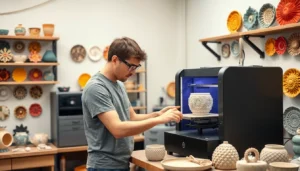Table of Contents
ToggleImagine a world where your wildest design dreams can come to life in a matter of hours. That’s the magic of EOS 3D printing, where innovation meets imagination. This technology isn’t just a fancy gadget; it’s a game-changer for industries ranging from aerospace to healthcare.
With EOS 3D printing, the limitations of traditional manufacturing vanish faster than a magician’s rabbit. It’s like having a personal genie that grants your design wishes—minus the three-wish limit. Whether it’s creating complex prototypes or custom parts, this powerhouse of precision is revolutionizing how products are made. Get ready to dive into the fascinating world of EOS 3D printing, where creativity knows no bounds and the future is literally at your fingertips.
Overview of EOS 3D Printing
EOS 3D printing stands at the forefront of additive manufacturing technology. This method utilizes a laser sintering process to transform powdered materials into solid structures layer by layer. Engineers and designers favor EOS 3D printing for its exceptional precision and ability to create complex geometries that traditional methods struggle with.
Various materials, such as metals and plastics, can be processed through EOS systems. The flexibility in material selection allows for the production of parts suited for high-performance applications, especially in demanding sectors like aerospace and medical. Fast and reliable production capabilities boost efficiency, slashing lead times significantly.
Industries leverage EOS technology to innovate and prototype more effectively. Organizations can experiment with designs quickly, facilitating rapid iteration and reducing overall development time. This accessibility enables companies to bring products to market faster while maintaining quality and performance standards.
Customer demands drive continual improvements in the technology. Ongoing advancements in software and hardware enhance the capability and efficiency of EOS systems. As a result, EOS 3D printing remains adaptable, meeting evolving industry needs and pushing the limits of manufacturing possibilities.
Adoption of EOS 3D printing fosters cost-effective solutions in production. By minimizing waste and optimizing material usage, organizations experience financial benefits. The growing trend in customized production makes EOS an attractive option for businesses aiming to differentiate themselves in competitive markets.
Key Features of EOS 3D Printing
EOS 3D printing stands out for its exceptional capabilities, making it a leader in additive manufacturing.
Material Options
EOS printers accommodate a diverse range of materials. For instance, they use metal powders such as titanium and aluminum, fitting various applications in aerospace and automotive sectors. Additionally, EOS expands its offerings with polymer materials like nylon and TPU, which serve industries demanding flexibility and durability. Each material option enhances performance characteristics, allowing for tailored solutions that meet specific client needs. Industries like healthcare benefit from biocompatible materials, enabling the production of customized implants and prosthetics.
Technology Used
The laser sintering process marks the core of EOS technology. This method fuses powdered materials layer by layer using high-energy lasers, resulting in precise solid structures. EOS employs advanced software algorithms to optimize parameters, ensuring consistent quality across builds. Each unit can produce complex geometries that traditional methods struggle to replicate, thus accelerating innovation. Users appreciate the ability to design intricate components without the constraints of molds or tooling. Continuous updates to hardware and software enhance overall functionality, positioning EOS 3D printing as a go-to solution for engineers and designers alike.
Applications of EOS 3D Printing
EOS 3D printing significantly impacts various industries, particularly aerospace and healthcare, where its unique capabilities enhance operational efficiency and product innovation.
Aerospace Industry
Aerospace companies increasingly rely on EOS 3D printing for producing lightweight and complex components. Designers create intricate geometries that traditional manufacturing methods struggle to achieve. Titanium and aluminum powders are popular choices for their strength and lightweight properties. These materials contribute to fuel efficiency and performance enhancements in aircraft design. Furthermore, rapid prototyping speeds up the testing process, reducing time to market. Engineers can refine designs before moving to full-scale production, ensuring optimal performance in demanding environments.
Medical Field
The medical field benefits from EOS 3D printing through custom implants and prosthetics tailored to individual patient needs. Biocompatible materials ensure compatibility with human tissue, minimizing rejection risks. Surgeons utilize patient-specific models for preoperative planning, enhancing surgical outcomes. Additionally, the technology allows for the production of complex, lightweight structures that improve comfort and functionality in medical devices. Customized tools, such as surgical instruments designed for specific procedures, also emerge from EOS capabilities, promoting precision and efficiency in medical settings.
Benefits of Using EOS 3D Printing
EOS 3D printing offers numerous advantages that set it apart from traditional manufacturing methods. Flexibility in production stands out as a key benefit. Engineers and designers create complex geometries that would otherwise be impossible to achieve.
Cost efficiency emerges through reduced material waste. The laser sintering process ensures optimal use of powdered materials, which translates to lower costs and enhanced margins for businesses.
Customization capabilities attract industries like healthcare and aerospace. Organizations utilize EOS technology to produce tailored components that meet specific performance and patient needs. Customized implants greatly reduce the risk of rejection due to the use of biocompatible materials.
Speed of production enhances responsiveness. Companies significantly shorten their design cycles with rapid prototyping. This accelerates testing and brings products to market faster, giving businesses a competitive edge.
Consistent quality marks EOS 3D printing as a leader in manufacturing processes. Advanced algorithms maintain stability throughout production, ensuring each component meets stringent standards regardless of complexity.
Material diversity further enriches the benefits of EOS 3D printing. Businesses access options ranging from metals like titanium and aluminum to flexible polymers like nylon and TPU. Such variety allows organizations to select the right materials for specific applications, enhancing overall performance.
Sustainability gains importance in modern manufacturing. EOS 3D printing minimizes waste through precise layering techniques, aligning with global initiatives for eco-friendly practices. By reducing environmental impact, industries can meet consumer expectations for sustainable production methods.
Overall, EOS 3D printing transforms traditional manufacturing approaches, presenting exceptional benefits for various sectors.
Challenges and Limitations
EOS 3D printing faces several obstacles that may impact its widespread adoption. High initial costs associated with EOS printers often pose a barrier for small to medium-sized enterprises. Maintenance expenses can also add up, as specialized training is typically required for effective operation.
Material limitations represent another challenge. Although EOS offers a variety of materials, not all materials provide compatibility with every printer model. This restriction can hinder the ability to select the ideal material for specific applications, particularly in industries demanding unique properties.
Speed can become a critical factor when producing complex parts. While EOS technology excels in precision, longer build times may occur for intricate designs, potentially delaying time to market. Engineers often find themselves balancing complexity with production efficiency during the design phase.
In addition, the learning curve for EOS software may create complications. New users often require additional time to master software tools effectively. This learning period can slow down initial productivity, posing challenges for companies trying to integrate EOS systems into existing workflows.
Lastly, intellectual property concerns arise in additive manufacturing. With the capability to replicate parts easily, companies may worry about safeguarding their proprietary designs. Effective strategies must be implemented to protect intellectual property to ensure that companies remain competitive.
EOS 3D printing undoubtedly presents remarkable benefits, yet awareness of these challenges and limitations is essential for organizations looking to adopt this advanced technology.
EOS 3D printing stands as a game-changer in modern manufacturing. Its ability to create complex geometries with unmatched precision opens up new avenues for innovation across various industries. By leveraging advanced laser sintering technology and a diverse range of materials, businesses can achieve tailored solutions that enhance performance and efficiency.
The benefits of EOS 3D printing extend beyond just production speed and cost savings. Its potential for customization and sustainability aligns perfectly with the evolving demands of the aerospace and healthcare sectors. While challenges exist, the continued advancements in technology promise to address these hurdles. As organizations explore EOS 3D printing, they’ll find a powerful tool that not only meets industry needs but also drives future growth and creativity.






